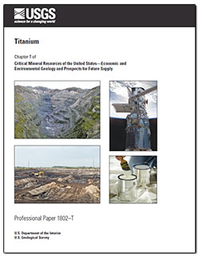Titanium
Links
- Document: Report (10.7 MB pdf)
- Larger Work: This publication is Chapter T of Critical mineral resources of the United States—Economic and environmental geology and prospects for future supply
- Download citation as: RIS | Dublin Core
Abstract
Titanium is a mineral commodity that is essential to the smooth functioning of modern industrial economies. Most of the titanium produced is refined into titanium dioxide, which has a high refractive index and is thus able to impart a durable white color to paint, paper, plastic, rubber, and wallboard. Because of their high strength-to-weight ratio and corrosion resistance, titanium metal and titanium metal alloys are used in the aerospace industry as well as for welding rod coatings, biological implants, and consumer goods.
Ilmenite and rutile are currently the principal titanium-bearing ore minerals, although other minerals, including anatase, perovskite, and titanomagnetite, could have economic importance in the future. Ilmenite is currently being mined from two large magmatic deposits hosted in rocks of Proterozoic-age anorthosite plutonic suites. Most rutile and nearly one-half of the ilmenite produced are from heavy-mineral alluvial, fluvial, and eolian deposits. Titanium-bearing minerals occur in diverse geologic settings, but many of the known deposits are currently subeconomic for titanium because of complications related to the mineralogy or because of the presence of trace contaminants that can compromise the pigment production process.
Global production of titanium minerals is currently dominated by Australia, Canada, Norway, and South Africa; additional amounts are produced in Brazil, India, Madagascar, Mozambique, Sierra Leone, and Sri Lanka. The United States accounts for about 4 percent of the total world production of titanium minerals and is heavily dependent on imports of titanium mineral concentrates to meet its domestic needs.
Titanium occurs only in silicate or oxide minerals and never in sulfide minerals. Environmental considerations for titanium mining are related to waste rock disposal and the impact of trace constituents on water quality. Because titanium is generally inert in the environment, human health risks from titanium and titanium mining are minimal; however, the processes required to extract titanium from titanium feedstock can produce industrial waste.
Suggested Citation
Woodruff, L.G., Bedinger, G.M., and Piatak, N.M., 2017, Titanium, chap. T of Schulz, K.J., DeYoung, J.H., Jr., Seal, R.R., II, and Bradley, D.C., eds., Critical mineral resources of the United States—Economic and environmental geology and prospects for future supply: U.S. Geological Survey Professional Paper 1802, p. T1–T23, https://doi.org/10.3133/pp1802T.
ISSN: 2330-7102 (online)
ISSN: 1044-9612 (print)
Table of Contents
- Abstract
- Introduction
- Geology
- Resources and Production
- Exploration for New Deposits
- Environmental Considerations
- Problems and Future Research
- References Cited
| Publication type | Report |
|---|---|
| Publication Subtype | USGS Numbered Series |
| Title | Titanium |
| Series title | Professional Paper |
| Series number | 1802 |
| Chapter | T |
| ISBN | 978-1-4113-3991-0 |
| DOI | 10.3133/pp1802T |
| Publication Date | December 19, 2017 |
| Year Published | 2017 |
| Language | English |
| Publisher | U.S. Geological Survey |
| Publisher location | Reston, VA |
| Contributing office(s) | Eastern Mineral and Environmental Resources Science Center |
| Description | viii, 23 p. |
| Larger Work Type | Report |
| Larger Work Subtype | USGS Numbered Series |
| Larger Work Title | Critical mineral resources of the United States—Economic and environmental geology and prospects for future supply |
| Online Only (Y/N) | N |
| Additional Online Files (Y/N) | N |


